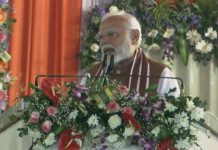 Even a few years ago, Faguni Goyari used to venture into the forest to collect firewood for cooking. But after the formation of Gambari Shikla Danai Lunai Ltd, a weaving cooperative society based in Kahibari, one of the fringe villages of Manas National Park in Assam, the widow having two children is happily leading 18 other Bodo women weavers.
Even a few years ago, Faguni Goyari used to venture into the forest to collect firewood for cooking. But after the formation of Gambari Shikla Danai Lunai Ltd, a weaving cooperative society based in Kahibari, one of the fringe villages of Manas National Park in Assam, the widow having two children is happily leading 18 other Bodo women weavers.
“We make different kinds of traditional items popular in Bodo culture like the dokhona, a traditional Bodo attire for women, and aronai or scarf. Ours is a registered group. Even though many among us knew weaving beforehand, we still received training in Guwahati for two days in 2019. It helped us improve a lot. Our group members were selected based on skill and economic dependency,” Goyari said. All the members of the cooperative are now busy weaving and prefer to do it in their respective homes for three to four hours every day. The women have earned approximately five lakh till now from this venture.
Weaver Savitri Goyari, who has a traditional loom at her home, informed that she was very happy to be trained in Guwahati. “It was my first time in the big city. I feel very happy to earn a living by weaving. Through this I am also able to support my family of three members. We also make gamchha, a traditional cotton towel used after bath, and bed covers
as well.”
 In Manas, the conservation success story involving the greater one-horned rhino is closely interlinked with community development. The women’s weaver group is earning a decent living from selling attractive handloom products to tourists. An improved market linkage is also helping them find customers outside. The group has been able to successfully sell products worth Rs 1 lakh to a businessman.
In Manas, the conservation success story involving the greater one-horned rhino is closely interlinked with community development. The women’s weaver group is earning a decent living from selling attractive handloom products to tourists. An improved market linkage is also helping them find customers outside. The group has been able to successfully sell products worth Rs 1 lakh to a businessman.
Anupam Sarmah of WWF India, who is the team leader for the Brahmaputra landscape, said since 2004-2005 the focus has been on how to extend all possible help to local communities living around the Manas National Park. Around this time, rhino translocation also started. Twenty animals were translocated to Manas from the Kaziranga National Park and the Pobitora Wildlife Sanctuary over a period of 12 years. Though many animals got poached, Manas currently has 43 rhinos. Sarmah attributed this success to conservation volunteers who came forward to help the forest department on their own. It has been a positive impact all along.
Helping local communities
Apart from the weaving initiative, some women are also part of the local culinary group and a dance troupe. Such alternative sources of livelihood are helping empower Bodo women and also promoting conservation in Manas. The cuisine idea has helped women showcase authentic Bodo food to tourists who visit the park.
Pijush Kumar Dutta, who is in charge of community engagement, wildlife and habitats programme at WWF India, said that in many places, tourists just arrive, take part in safari and leave straightaway. “To change this, local communities were involved in setting up centres where tourists can come and enjoy Bodo culture, dancing and food. All these activities ensure that visitors stay behind an extra day.”
 It is the women who actually run these centres. Over the past two years they have also started earning a decent amount. Most of these villages are remote and the residents mainly practise animal husbandry and subsistence farming for livelihood.
It is the women who actually run these centres. Over the past two years they have also started earning a decent amount. Most of these villages are remote and the residents mainly practise animal husbandry and subsistence farming for livelihood.
Julie Basumatary performs the Bodo dance and also cooks tasty traditional food. “We are regularly called to the Manas National Park whenever tourists visit and each performance fetches 3000 to 4000. There are 30 members in the dance troupe also known as bagurumba locally,” she said. All women from Bodo community know dancing, but as they are not professional dancers, they received training for perfection.
The women have been trained in cooking as well by Mitali G Dutta, a culinary entrepreneur based in Guwahati. She is both into cooking and baking. One of the women said they cook rice and traditional dishes like onla, a meat prepared with rice flour and traditional spices. It is considered the identity of Bodo culture. A traditional food platter costs 500 depending on the menu, informed Shantina Basumatary who loves cooking for tourists. She is from Barangabari village adjoining Manas. “Earlier, I used to depend on the forest a lot as well as on fishing for survival. Now, we are earning through these initiatives which is of great help to my family comprising four members,” she said. Many households in her village also own gas cylinders and are not dependent on firewood collection anymore.
Mitali explained that she went to Manas to train the women who are traditionally great cooks. There are two groups, and the one called Sumaina, consists of 10 women. “My focus was mainly on culinary training. Since they have to host visitors, they needed training in the hospitality part to make their products marketable. The women showed me their practical work and were amazing to work with,” she said. But as they were not at all into the business aspect, this area needed support, the entrepreneur added. The women need markets and intensive training in capacity building.
Conservation volunteers have been the backbone of the success story in Manas. As there is not much monetary aid for them for working towards conservation, looking at their contribution it was felt that their families must have financial security. It was with this idea that these initiatives were launched.
According to Deba Dutta of WWF, though the rhino population is at present stable in Manas, there is still a lot more to do and the local community is very supportive. At one time, rhinos used to enter the villages but the Bodo community feels positively towards the animal and hence they were involved. Dutta has been working in Manas for the past 14 years. The landscape coordinator vouches that visits to forest have definitely reduced after the initiatives took off. “The local people act as watchers and provide timely information when animals enter their villages. There was a lot of unrest during the Bodo agitation and it took a toll on wildlife as poaching increased. But now things have stabilised,” Dutta said.
Involving communities can also be part of the Earth Hour. As a global environmental movement, it can go far beyond than just the switching off lights by becoming a catalyst for positive environmental impact and collective action at the grassroots level.
letters@tehelka.com












